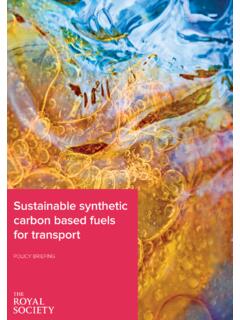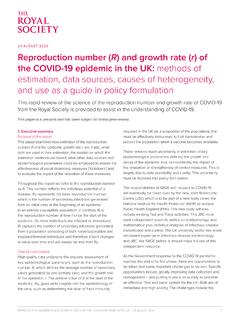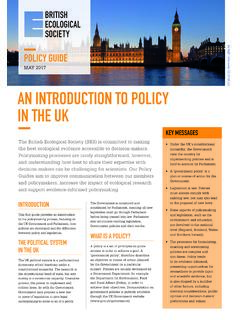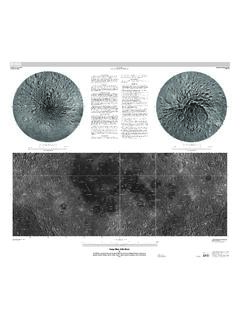Transcription of Report: Greenhouse Gas Removal - Royal Society
1 Greenhouse gas removalCover image Visualisation of global atmospheric carbon dioxide surface concentration by Cameron Beccario, , using GEOS-5 data provided by the Global Modeling and Assimilation Office (GMAO) at NASA Goddard Space Flight 2017 the Royal Society and Royal Academy of Engineering were asked by the UK Government to consider scientific and engineering views on Greenhouse gas Removal . This report draws on a breadth of expertise including that of the Fellowships of the two academies to identify the range of available Greenhouse gas Removal methods, the factors that will affect their use and consider how they may be deployed together to meet climate targets, both in the UK and Royal Society and Royal Academy of Engineering would like to acknowledge the European Academies Science Advisory Council report on negative emission technologies ( ), which provided a valuable contribution to a number of discussions throughout this gas Removal Issued: September 2018 DES5563_1 ISBN.
2 978-1-78252-349-9 The text of this work is licensed under the terms of the Creative Commons Attribution License which permits unrestricted use, provided the original author and source are credited. The license is available at: are not covered by this report can be viewed online at: : The first edition of this report incorrectly listed the area of saltmarsh in the UK as Mha, which is instead Mha. This error has been corrected in the UK scenario on p96 and the corresponding GGR for habitat restoration adjusted. The conclusions of this report and the UK net-zero scenario remain of abbreviations 5 GGR methods 6 Foreword 7 Executive summary 8 Recommendations 10 Introduction 13 Chapter one Greenhouse gas Removal The carbon cycle Removal and storage 20 Chapter two GGR methods Afforestation, reforestation and forest management Wetland.
3 Peatland and coastal habitat restoration Soil carbon sequestration Biochar Bioenergy with carbon capture and storage (BECCS) Ocean fertilisation Building with biomass Enhanced terrestrial weathering Mineral carbonation Ocean alkalinity Direct air capture and carbon storage (DACCS) Low-carbon concrete Other GGR approaches Removal of gases other than CO2 66 Chapter three Cross-cutting issues Introduction Resources Storage Environment Science and technology Economics Legislation Social aspects 86 Greenhouse GAS Removal 3 CONTENTSC hapter four Scenarios GGR pathway building UK scenario annual GGR of 130 MtCO2 in 2050 Global scenario 810 GtCO2 by 2100 104 Chapter five Lessons learned from scenarios Lessons learned from scenarios 114
4 Acknowledgments, working group and staff 120 References 1244 Greenhouse GAS REMOVALCONTENTSList of abbreviationsBECCS bioenergy with carbon capture and storageC carbonCCS carbon capture and storageCO2 carbon dioxide CO2e carbon dioxide equivalents. A measure used to compare warming levels between CO2 and other Greenhouse gasesDAC direct air captureDACCS direct air capture with carbon storagekJ/MJ/GJ/EJ kilojoules/megajoules/ gigajoules/exajoulesGGR Greenhouse gas removalha hectareIPCC Intergovernmental Panel on Climate ChangeNDC nationally determined contributionspa per annumppm parts per million SDGs United Nations Sustainable Development GoalsSRM solar radiation managementTRL technology readiness levelTWh terawatt hourstCO2/MtCO2/GtCO2 tonnes/megatonnes/ gigatonnes of carbon dioxide.
5 Where literature cites values in terms of carbon (tC/MtC/GtC) these have been converted to CO2 by multiplying by $ currency throughout the report is presented in USD unless stated GAS Removal 5 Greenhouse gas Removal (GGR) methodsForestation Growing new trees and improving the management of existing forests. As forests grow they absorb CO2 from the atmosphere and store it in living biomass, dead organic matter and restoration Restoration of peatlands and coastal wetlands to increase their ability to store carbon. This also prevents carbon release through further degradation, often providing a number of other carbon sequestration Changing agricultural practices such as tillage or crop rotations to increase the soil carbon Incorporating partially-burnt biomass into soils.
6 Biomass is grown and burned in the absence of oxygen (pyrolysis) to create a charcoal-like product which can stabilise organic matter when added to the with carbon capture and storage (BECCS) Utilising biomass for energy, capturing the CO2 emissions and storing them to provide life cycle fertilisation Applying nutrients to the ocean to increase photosynthesis and remove atmospheric with biomass Using forestry materials in building extends the time of carbon storage of natural biomass and enables additional forestry terrestrial weathering Ground silicate rocks spread on land react with CO2 to remove it from the carbonation Accelerating the conversion of silicate rocks to carbonates either above or below the surface to provide permanent storage for alkalinity Increasing ocean concentration of ions like calcium to
7 Increase uptake of CO2 into the ocean, and reverse air capture and carbon storage (DACCS) Using engineered processes to capture atmospheric CO2 for subsequent concrete Altering the constituents, the manufacture, or the recycling method of concrete to increase its storage of METHODS6 Greenhouse GAS REMOVALF oreword There is overwhelming scientific evidence that the human release of Greenhouse gases is changing the Earth s climate. At Paris, countries from around the world committed to limiting the damage caused by this change, agreeing to keep warming to under 2 C. The role of rapid emissions reduction in meeting this target is widely understood.
8 But it is increasingly clearer that reducing emissions is not enough we must also actively remove Greenhouse gases from the atmosphere. New technologies have emerged that show promise in removing CO2 from the atmosphere but these are not well understood and mostly unproven at large report brings together the expertise of the Royal Society and Royal Academy of Engineering to outline how much we know now about each of these methods and, for the first time, to consider how they might be deployed alongside each other to meet climate goals in the UK and two scenarios in this report identify the suite of technologies that together can help us get to a carbon neutral future in the UK by 2050, and globally by the end of the century.
9 They are a sobering reminder of how much work there is to do to secure the wellbeing of our challenge ahead is not insurmountable, but it requires the full weight of the world s research community. Scientists and engineers of all types will need to pull together with social scientists, economists, the public and policymakers to develop, deploy and manage methods that range from planting trees to engineering the direct Removal of CO2 from the air. This remains a developing field and much will change over the coming decades, but as this report shows, action must begin pProfessor Dame Ann Dowling, President of the Royal Academy of Ramakrishnan, President of the Royal GAS Removal 7 Executive summaryIn 2015, governments from around the world met to agree a framework that would minimise the negative consequences of climate change.
10 The Paris Agreement sets a goal to limit global average temperature increase to well below 2 C above preindustrial levels , and to pursue efforts to limit it to is an ambitious task requiring rapid decreases in emissions and, by the second half of the century, net-zero emissions. In some sectors, notably agriculture and aviation, Greenhouse gas emissions will be difficult to eliminate entirely, so we will need technologies to compensate by removing Greenhouse gases from the atmosphere. Modelling of future energy systems suggests this Removal would need to be at a large scale, with Removal of about one quarter of present annual emissions each gas Removal (GGR) methods involve two main steps: the Removal of Greenhouse gases from the atmosphere and their storage for long periods.
















